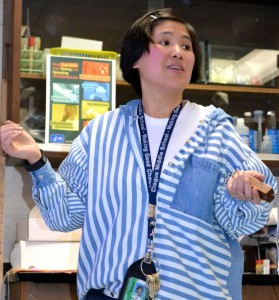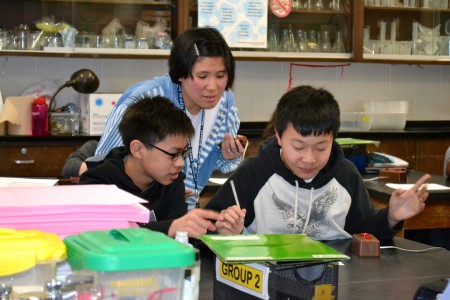
Clague Middle School teacher Soon Morningstar is a co-recipient of the 2015 Science/Math Teacher of the Year Award for Middle/High Schools in the Greater Washtenaw County Area.
The award is given annually by the University of Michigan Chapter Of Sigma Xi, Scientific Research Society. She was nominated by Clague Principal Che´Carter.
She has been teaching at Clague Middle School since 2000, and is currently teaching eighth grade physical science and one class of seventh grade math.
AAPS News Editor Jo Mathis talked to Morningstar about the work she finds so satisfying.
What inspired you to become a teacher, and what motivates you to continue?
I was between jobs, and my mom, who was a special education administrator for Plymouth-Canon School District, called me up and said, “I want you to come to this middle school here in Plymouth for three days and be an aide for a student who has cerebral palsy.” I enjoyed the experience, and the following fall, I signed up to become a substitute teacher for two school districts to figure out what age group I liked. Then I went back to school and got my master’s degree and certification for elementary and middle school math/science.
What motivates me to continue is that I like to show students that math and science can be fun and try to show them real world applications that they can relate to. I like to see the excitement in the students when they grasp and idea and get excited about their own learning.
I was rejuvenated when I was selected to go to Singapore, funded by Toyota, this past summer to learn about their STEM/STEAM education. The trip gave me many new insights into what more I can do to make my class and my teaching style even stronger for the students and to help them become 21st Century learners.
2: How would you describe your teaching style?
My teaching style is where I strongly believe in student-centered and cooperative learning. I want the students to learn from each other as well as from me, yet I want them to have fun. I do a lot of labs and group discussions with all of my classes, because I feel that students learn best by hands-on activities and real-world application. The labs are the most fun for the student. And for kinesthetic learners and visual learners, it is very helpful. I feel it is very powerful. I try to make sure I reach all of my students by different modalities of teaching—from oral to visual to kinesthetic and our special needs students.
In math, students peer critique each other on their homework, so it is more student-centered and they become more comfortable with understanding the work. When students can explain a problem to another student, then it helps them that much more to have a better grasp of concepts themselves.
Can you share some practical on-the-job tips?
Communication is huge. Communicate effectively to the parents and to the students. Students want to know why the decisions have been made, not “just because I said so.” Give students choices that you are okay with.
Listen to your students with an open mind, because you don’t know what kind of background they are coming from. And make any necessary accommodations to make that student be successful in school and to feel wanted and heard.
What are the hardest and most rewarding parts of your work?
The hardest of the job is being able to help everyone, especially those who don’t want it. I am saddened when I see a student struggle, and I reflect on what more could I have done to better prepare them to be successful in my class. What more could I do to help them to be successful in my class?
The most rewarding part for me is to see the excitement in the students’ eyes when they understand a concept from the labs we do and the discussions we have. Then they get excited and want to learn more.
If you could change two things about the current educational system in the U.S., what would they be?
1) Stop cutting into the education funds. Allow the district to hire the confident teachers they need so we can decrease our class sizes and be able to better accommodate all of our students.
2) Have more respect for our teachers and pay our teachers what they are due. I believe some of these government officials need to step in a classroom and experience the day-to-day life of a teacher so they have a better understanding of how teachers have to accommodate all kinds of learners.
What do you wish everyone knew about the teaching profession?
Teaching is a tough job to do it right. You have to be willing to put in the time and have to have patience to help students, even those who don’t really want the help. With larger class sizes, it has been more difficult to be able to give students their individual attention and to be able to make the accommodations to make everyone successful. We are setting the future for our young people and if we alienate them, then we will not have the skilled and/or talented people to do the jobs in the future, and even jobs that have yet to be created as we try to move them into the 21st Century.
What are your strengths and weaknesses?
Weakness: Maybe I am too demanding and give out too much homework for the students. I work all the time when I am at home.
Strengths: I work hard and am always willing to give a lending hand to anyone who reaches out and asks for it. I set high standards for all of my students so I can prepare them for high school.
How would you advise a college freshman considering a major in education?
I would tell them that they have to enjoy working with students, and to try doing a little substituting to be exposed to a classroom so they have a sense of the challenges they may encounter. Also, to get two different certifications so that they are more marketable and teach what they love.


Ann Arbor Public Schools can be proud of the former student Soon (Hotaling) Morningstar. She went to Wines Open School and graduated from Community HS.She had some inspiring teachers and I am happy that she followed in their footsteps. She loves teaching and respects the students’individuality and wants everybody to be successful She is a truly dedicated teacher and a wonderful friend to all of her students and her fellow teachers.